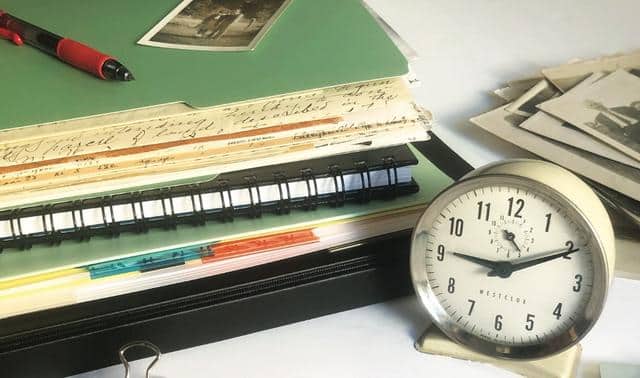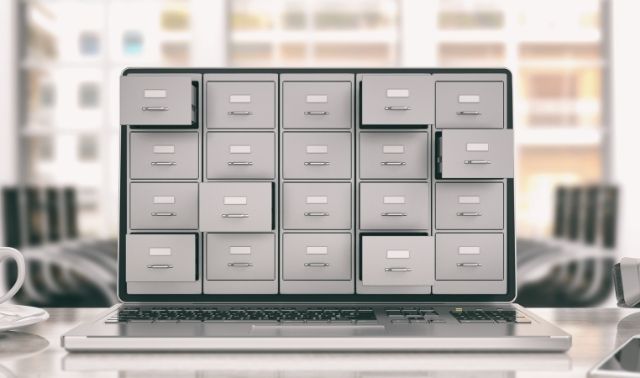Sign up for the Family Tree Newsletter! Plus, you’ll receive our 10 Essential Genealogy Research Forms PDF as a special thank you.
Get Your Free Genealogy Forms
"*" indicates required fields

Spring is the perfect time of year to clean up your workspace, and to make sure your research is being properly cared for. Use the suggestions below to plan your own spring cleaning and organization projects.
For more, check out our free, downloadable Spring Cleaning Guide for Genealogy.
Create a Filing System
There are multiple different genealogy filing systems to choose from, and the right one for you will depend on your unique research. A good beginner strategy is to organize files by surname with sub sections for each ancestor.
Consider creating a “filing station” or “drop zone” in your workspace with a trash can, recycle box and trays or boxes to collect items to digitize or file away later.
Create a File Naming System for Digital Items
One of the best ways to streamline your digital organization is to create a consistent file naming system. Decide on your system and keep it handy so you can reference it until naming your files becomes second nature. It will make a world of difference the next time you’re searching for a specific photo, document or other file.
Plan a Scanning Day
Many genealogists have a pile of items that are waiting to be digitized. Scanning can be a huge project and depending on the size of your collection, it can take quite a while.
Prepare yourself for success by blocking off a day on your calendar to devote to scanning. Before scanning day, decide how you are going to scan your items and acquire the appropriate equipment or download and set up any apps that you’ll be using.
If you haven’t already, decide how you’ll name and file your newly-scanned items. And finally, gather together all the materials to be scanned. With all the prep work done, you’ll be ready to hit the ground running.
Take Inventory of Heirlooms
Gather together all your family keepsakes and heirlooms. Systematically go through and purge any items that don’t have a practical, genealogical or sentimental value.
Make a plan for how to safely store your family collection and shop for any archival materials you might need. Look for item-specific conservation guidelines on the American Institute for Conservation website.
Consider photographing heirlooms and/or writing an account to store with them to preserve any relevant genealogical information.
Set Up an Organization and Backup Routine
Setting up a routine is a great way to stay organized, whether it’s one day a week, one day a month or even taking five minutes after each research session to organize, file and rename items.
It’s best practice to also have some sort of digital backup routine to protect your genealogy from disaster and safeguard it for future use. Consider keeping three copies of important files: one on your device, one in external storage and one in cloud-based storage.
Organization Tips from Our Readers
Here are tips from our readers about how they tackle their genealogy spring cleaning checklist.
“I color coded my four grandparents’ lines, so that I can easily grab a folder or whatever as I need it. I used red, yellow, blue and green, so I can easily use colored pens, pencils, binders, stickers, etc., to sort, tag and mark boxes and pages, color-code categories in my Outlook email browser for tasks and contacts, etc.”
– Anita B.
As I find dates pertinent to an ancestor, I enter it into an Excel file. For instance, my grandfather was a chef in Chicago and as I run across correspondence from an employer or information on his draft card, I’ll put the employer’s name and the date he was employed there. I have a file for each relative to update when I find fun facts.
– Luanne N.
A lot of the time when I can’t find a copy of a paper, I just make more copies until I don’t know what the original is. When you make or get the first copy of something, make a small mark on it with a yellow highlighter. It will not show up when you make a black-and-white copy, so you’ll always know which is the original.
– Herbert B.
I have written up a SOP (Standard Operating Procedure) for my digital files. This way I am saving photos and documents the same way and I’l be able to find them later.
– Tina T.
For future generations and their organization—I am collecting autographs from family members. I take my autograph book with me at family get togethers, reunions, and whenever we have a chance to visit family out of state.
– Marsha L.
I file all documents, photos and other items in chronological order in binders using sheet protectors. Each binder starts with a couple’s marriage and ends with their death. As each of their children marries, a page is inserted directing reader to a new binder starting with the marriage of that child.
– Jan R.
I’ve scanned all of my parents’ and grandparents’ photos to Flickr. That way the photos are safe if my house gets blown away by a tornado. I’ve created “sets” for each grandparent, aunt, uncle, etc. If a family member is interested, I can send the link to the person they’re inquiring about. I have the majority of pictures labeled with who they are and other information.
– Melissa H.
I have a great little multi-sectioned notebook in which I’ve dedicated a section for each family I am researching. I no longer have bits of paper and post-its wandering around my research space. It fits inside my purse so I can bring it with me.
– Sharon S.
As I receive papers, I make a goal to scan them right away. The original then enters my folder that is building up continuously. Once that folder is full, the sorting begins.For digital materials, I have a folder on my computer desktop. There’s nothing like a good movie to sit there and watch while sorting through, documenting information and putting them into their digital folders!
– Sarah S.
I used OneNote to organize all those pieces of information that just don’t fit into the family tree—at least not yet. I have a scribbler called Family History with tabs for each family surname. When I find information that I’m unsure fits, I enter it under the appropriate family tab then on the individual’s page. I make sure I put the source, so when I want to go back to that information I know where I can find it. You can make other scribblers, such as research logs, genealogy general information or anything else you’d like to keep track of.
– Ellen T.
Shut your office door when people arrive. Don’t forget to migrate stuff into your storage room. Close the door fast, before it escapes!
– Carolyn H.
Related Reads
Last updated: April 2024








